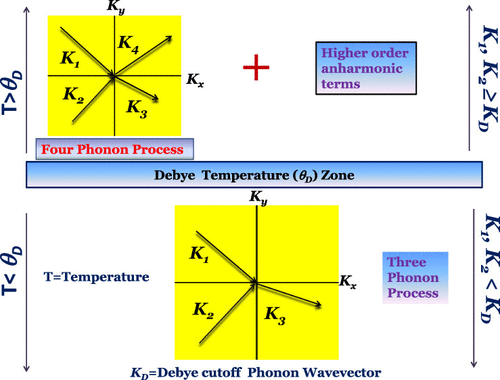当前位置:
X-MOL 学术
›
J. Phys. Chem. C
›
论文详情
Our official English website, www.x-mol.net, welcomes your feedback! (Note: you will need to create a separate account there.)
Temperature-Dependent Cationic Doping-Driven Phonon Dynamics Investigation in CdO Thin Films Using Raman Spectroscopy
The Journal of Physical Chemistry C ( IF 3.7 ) Pub Date : 2020-09-22 , DOI: 10.1021/acs.jpcc.0c06632 Arkaprava Das 1 , Deobrat Singh 2 , Anumeet Kaur 3 , C. P. Saini 4 , D. Kanjilal 4 , C. Balasubramanian 1, 5 , Joydip Ghosh 6 , Rajeev Ahuja 2, 7
The Journal of Physical Chemistry C ( IF 3.7 ) Pub Date : 2020-09-22 , DOI: 10.1021/acs.jpcc.0c06632 Arkaprava Das 1 , Deobrat Singh 2 , Anumeet Kaur 3 , C. P. Saini 4 , D. Kanjilal 4 , C. Balasubramanian 1, 5 , Joydip Ghosh 6 , Rajeev Ahuja 2, 7
Affiliation

|
In the present work, undoped cadmium oxide (CdO)- and 1% Tin (Sn)-doped CdO thin films were prepared by the sol–gel route. These samples have been analyzed by temperature (T)-dependent (80–500 K) Raman spectroscopy and studied for their lattice dynamics and vibrational density of states. Results indicate that the room T synthesized pure CdO thin film manifests two prime second order features, that is, 300.5 cm–1 transverse optical (TO) and 488 cm–1 longitudinal optical (LO) phonon modes. However, incorporation of cationic-assisted impurity (Sn) with larger ionic radii results in a softening of the high-frequency LO (480.5 cm–1) mode via lattice deformation scattering potential. In fact, selective Sn doping increases the carrier concentration in the host CdO matrix which subsequently mitigates intraionic anharmonicity owing to increased Coulomb screening, leading to disappearance of the low-frequency TO mode (300.5 cm–1). In the case of pure CdO thin films, surface electron-induced electron–LO phonon coupling causes the intensity enhancement in LO modes, while negligible four-phonon anharmonic coupling results in lowering of full width at half maxima below Debye T. On the other hand, Frühlich interaction in the polar LO phonon mode supersedes the impact of anharmonic decay and dominates the overall phonon decay process by impurity incorporation, via appropriate Sn doping. Theoretical phonon dispersion profiles throughout the Brillouin zone with increasing T suggests stronger TO phonon mode softening along with optical branch broadening followed by LO–TO splitting. The acoustic branch barely suffers any shift with changing T which cannot be observed in experimental spectra. However, the flexural phonon modes confer a direct indication of changed rigidity and bond stiffness with varying T. Overall, the present investigation provides experimental evidence regarding the significance of Debye T, below and above which the three- and four-phonon anharmonicity are feasible in phonon scattering in conjunction with theoretical insights.
中文翻译:

使用拉曼光谱研究CdO薄膜中随温度变化的阳离子掺杂驱动声子动力学
在本工作中,通过溶胶-凝胶法制备了未掺杂的氧化镉(CdO)和1%的锡(Sn)掺杂的CdO薄膜。这些样品已经通过依赖温度(T)(80–500 K)的拉曼光谱进行了分析,并研究了其晶格动力学和态振动密度。结果表明,室温T合成的纯CdO薄膜表现出两个主要的二阶特征,即300.5 cm –1的横向光学(TO)和488 cm -1的纵向光学(LO)声子模。但是,将阳离子辅助杂质(Sn)与较大的离子半径结合使用会导致高频LO(480.5 cm –1晶格变形散射势)实际上,选择性的Sn掺杂会增加宿主CdO基质中的载流子浓度,由于库仑筛查的增加,随后减轻了离子内非谐性,导致低频TO模式(300.5 cm –1)消失。在纯CdO薄膜的情况下,表面电子感应的电子-LO声子耦合会导致LO模式下的强度增强,而可忽略的四声子非谐耦合会导致在Debye T以下一半处的全宽度降低。。另一方面,极性LO声子模式下的Frühlich相互作用取代了非谐衰变的影响,并通过适当的Sn掺杂通过掺入杂质控制了整个声子衰变过程。随着T的增加,整个布里渊区的理论声子色散分布图表明,较强的TO声子模态软化以及光学分支加宽,然后发生LO–TO分裂。声学支路几乎不会随T的变化而发生变化,这在实验光谱中无法观察到。但是,挠曲声子模式可以直接指示随着T的变化而改变的刚度和结合刚度。总体而言,本研究提供了有关Debye T重要性的实验证据,下面和上面,结合理论观点,在声子散射中三声子和四声子非谐性是可行的。
更新日期:2020-10-02
中文翻译:

使用拉曼光谱研究CdO薄膜中随温度变化的阳离子掺杂驱动声子动力学
在本工作中,通过溶胶-凝胶法制备了未掺杂的氧化镉(CdO)和1%的锡(Sn)掺杂的CdO薄膜。这些样品已经通过依赖温度(T)(80–500 K)的拉曼光谱进行了分析,并研究了其晶格动力学和态振动密度。结果表明,室温T合成的纯CdO薄膜表现出两个主要的二阶特征,即300.5 cm –1的横向光学(TO)和488 cm -1的纵向光学(LO)声子模。但是,将阳离子辅助杂质(Sn)与较大的离子半径结合使用会导致高频LO(480.5 cm –1晶格变形散射势)实际上,选择性的Sn掺杂会增加宿主CdO基质中的载流子浓度,由于库仑筛查的增加,随后减轻了离子内非谐性,导致低频TO模式(300.5 cm –1)消失。在纯CdO薄膜的情况下,表面电子感应的电子-LO声子耦合会导致LO模式下的强度增强,而可忽略的四声子非谐耦合会导致在Debye T以下一半处的全宽度降低。。另一方面,极性LO声子模式下的Frühlich相互作用取代了非谐衰变的影响,并通过适当的Sn掺杂通过掺入杂质控制了整个声子衰变过程。随着T的增加,整个布里渊区的理论声子色散分布图表明,较强的TO声子模态软化以及光学分支加宽,然后发生LO–TO分裂。声学支路几乎不会随T的变化而发生变化,这在实验光谱中无法观察到。但是,挠曲声子模式可以直接指示随着T的变化而改变的刚度和结合刚度。总体而言,本研究提供了有关Debye T重要性的实验证据,下面和上面,结合理论观点,在声子散射中三声子和四声子非谐性是可行的。


























 京公网安备 11010802027423号
京公网安备 11010802027423号